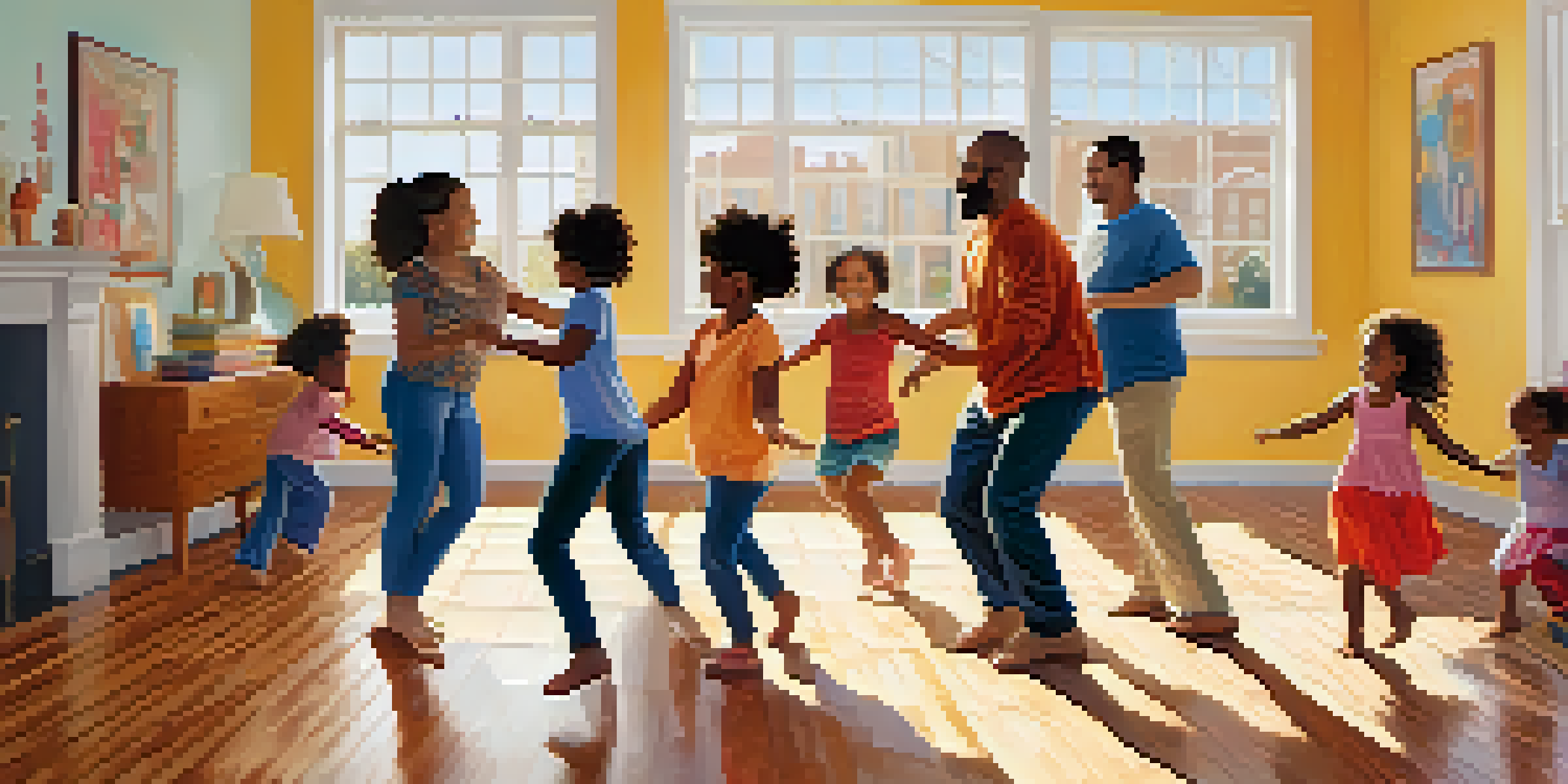Dance Therapy: Strengthening Family Relationships Effectively

Understanding Dance Therapy and Its Benefits
Dance therapy, or dance movement therapy, is a form of expressive therapy that uses movement to promote emotional, cognitive, and social integration. It allows individuals to express their feelings and experiences through dance, making it a powerful tool for healing and connection. For families, this therapy offers a unique way to communicate and bond without the constraints of words.
Dance is the hidden language of the soul.
By engaging in dance, family members can discover new ways to connect with each other, often leading to deeper understanding and empathy. The shared experience of movement can foster a sense of unity and collaboration among family members. Plus, it can be a fun and playful way to relieve stress and tension that might exist within the family dynamic.
Moreover, dance therapy can cater to all ages, making it an inclusive activity for families. Whether it's a toddler, teenager, or adult, everyone can find joy and expression through movement. This inclusivity helps strengthen familial ties by creating shared memories and experiences.
Creating a Safe Space for Expression
One of the key elements of dance therapy is the creation of a safe and non-judgmental environment. Families are encouraged to express themselves freely, allowing for authentic connection without fear of criticism. This safe space is crucial for fostering trust among family members, enabling open communication and vulnerability.

In this supportive setting, individuals can explore their emotions and experiences through movement. For example, a parent might express feelings of anxiety through frantic movements, while a child might convey joy through playful dance. Such expressions can prompt discussions that deepen understanding and empathy among family members.
Dance Therapy Enhances Family Bonds
Engaging in dance therapy allows families to express emotions and connect on a deeper level through shared movement.
Additionally, this safe space encourages creativity and spontaneity, which can lead to unexpected moments of joy and laughter. These shared joyful experiences can create lasting bonds, reinforcing the idea that family is a source of support and love.
Building Trust Through Shared Movement
Trust is a vital component of any relationship, and dance therapy can help families build this essential foundation. As family members move together, they learn to rely on one another, fostering a sense of teamwork and collaboration. This shared experience can break down barriers and cultivate an atmosphere of support.
The body says what words cannot.
For instance, when a family engages in a group dance, they must coordinate their movements, which requires communication and mutual respect. These interactions can lead to greater appreciation for each other's strengths and contributions, enhancing trust within the family unit. Over time, these positive interactions can translate into more effective communication in everyday life.
Moreover, the physicality of dance can reinforce emotional connections. When family members dance together, they often share physical touch and proximity, which can be incredibly reassuring. This simple act of being close can strengthen their emotional bonds and create a sense of belonging.
Enhancing Communication Skills Through Dance
Dance therapy can significantly improve communication skills within families. As family members engage in non-verbal forms of expression, they learn to read each other's body language and emotional cues. This heightened awareness can lead to more effective communication overall, both verbally and non-verbally.
For example, a child might learn to recognize when a parent is feeling stressed or overwhelmed, prompting them to offer support. Similarly, parents may become more attuned to their children's emotional states, allowing for timely and compassionate responses. This mutual understanding can create a more harmonious family environment.
Safe Space Promotes Open Expression
Creating a non-judgmental environment in dance therapy encourages family members to express themselves freely, fostering trust and communication.
Furthermore, the process of learning new dance moves together can encourage patience and teamwork. As family members practice and support each other, they develop skills that translate to better communication outside of dance therapy. This newfound ability to express thoughts and feelings can lead to healthier family dynamics.
Fostering Emotional Resilience Through Dance
Emotional resilience is the ability to adapt and recover from challenges, and dance therapy can play a pivotal role in fostering this quality within families. Engaging in dance allows family members to explore and express a range of emotions, including joy, sadness, and frustration. This exploration can lead to greater emotional awareness and coping strategies.
For instance, through dance, a family might confront feelings related to a recent loss or change. By expressing these emotions physically, they can process their feelings together, ultimately finding healing and closure. This shared journey can strengthen familial bonds and promote resilience as they navigate life's ups and downs.
Moreover, developing emotional resilience through dance can empower family members to face challenges more effectively in the future. As they learn to express and manage their emotions, they become better equipped to handle stress and adversity together, reinforcing the idea that they can rely on one another in tough times.
Encouraging Playfulness and Joy in Family Life
In the hustle and bustle of daily life, it's easy for families to become bogged down by responsibilities and stress. Dance therapy offers a refreshing break, encouraging families to embrace playfulness and joy. By prioritizing fun and creativity, families can rekindle their sense of togetherness and happiness.
During dance therapy sessions, families can let loose and be silly, allowing for laughter and joy to fill the space. This playful atmosphere can act as a reset button for family dynamics, helping to alleviate tension and promote positive interactions. As families engage in light-hearted movement, they often discover new aspects of each other’s personalities.
Professional Guidance Maximizes Benefits
Working with certified dance therapists can tailor experiences to family dynamics, enhancing the effectiveness of the therapy.
Additionally, these joyful experiences can lead to lasting memories and traditions. Whether it's a weekly dance night at home or attending a dance therapy session together, these moments of joy can become cherished family rituals. In turn, these traditions can foster a strong sense of identity and belonging within the family.
Finding Professional Guidance in Dance Therapy
If you're considering dance therapy as a way to strengthen family relationships, seeking professional guidance can be invaluable. Certified dance therapists are trained to facilitate meaningful experiences that cater to the unique dynamics of each family. They can tailor sessions to address specific challenges and goals, ensuring that the therapy is effective.
Working with a professional not only provides structure but also creates a safe environment for exploration and expression. They can introduce various techniques and activities that encourage family members to engage with one another in new ways. This guidance can enhance the overall experience and ensure that families get the most out of their time together.

Moreover, professionals can offer insights and strategies that families can implement outside of therapy sessions. This ongoing support can help families maintain and strengthen the connections they've built through dance therapy, promoting lasting change and growth.